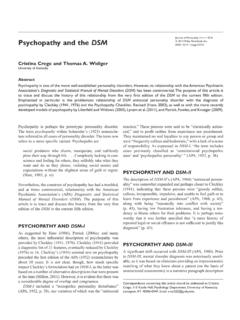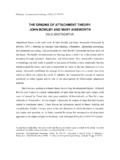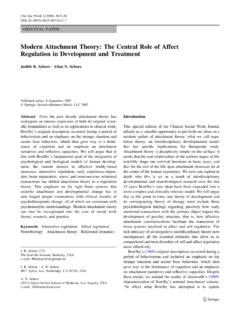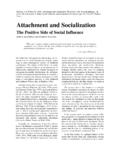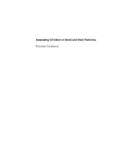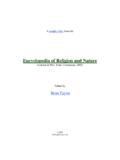Transcription of Bowlby Attachment Theory - sakkyndig
1 HomeAttachment PsychologyMary AinsworthPrivationDeprivation SearchBowlby AttachmentTheoryBowlby ChildDevelopmentJohn Bowlbywas apsychoanalyst(like Freud) andbelieved thatmental healthand behaviouralproblems couldbe attributed toearly sevolutionarytheory of Attachment suggests thatchildren come into the world biologicallypre-programmed to form attachments with others, because this will help them to was very much influenced by ethological Theory in general, but especially byLorenz s (1935) study of imprinting. Lornez showed that Attachment was innate (inyoung ducklings) and therefore has a survival believed that Attachment behaviours are instinctive and will be activated byany conditions that seem to threaten the achievement of proximity, such as separation,insecurity and (1969, 1988) also postulated that the fear of strangers represents an importantsurvival mechanism, built in by nature.
2 Babies are born with the tendency to displaycertain innate behaviours (called social releasers) which help ensure proximity andcontact with the mother or mother figure ( crying, smiling, crawling, etc.) these arespecies-specific the evolution of the human species, it would have been the babies who stayedclose to their mothers who would have survived to have children of their own andBowlby hypothesised that both infants and mothers have evolved a biological needto stay in contact with each other. These Attachment behaviours initially function likeSigmund Freud ResearchOnline books, journals for academic research, plusbibliography m/mange bilderLag eksklusive kort.
3 1-2-4 siders. Kule gaver,kalendere, fotob JobsThe British Psychological Society's gateway to 100'sof Psychology and Well-BeingApplied Psychology Read the new journal from action patterns and all share the same function. The infant produces innate socialreleaser behaviours such as crying and smiling that stimulate caregiving from determinant of Attachment is not food but care and responsiveness. Bowlbysuggested that a child would initially form only one Attachment and that the attachmentfigure acted as a secure base for exploring the world. The Attachment relationship acts asa prototype for all future social relationships so disrupting it can have Main Points of Bowlby s Attachment Theory :1.
4 A child has an innate ( inborn) need to attach to one main Attachment figure( monotropy).Although Bowlby did not rule out the possibility of other Attachment figures for a child,he did believe that there should be a primary bond which was much more important thanany other (usually the mother). Bowlby believes that this Attachment is different in kind (qualitatively different) fromany subsequent attachments. Bowlby argues that the relationship with the mother issomehow different altogether from other , Bowlby suggested that the nature of monotropy ( Attachment conceptualisedas being a vital and close bond with just one Attachment figure) meant that a failure toinitiate, or a breakdown of, the maternal Attachment would lead to serious negativeconsequences, possibly including affectionless psychopathy.
5 Bowlby s Theory ofmonotropy led to the formulation of his maternal deprivation A child should receive the continuous care of this single most importantattachment figure for approximately the first two years of (1951) claimed that mothering is almost useless if delayed until after two and ahalf to three years and, for most children, if delayed till after 12 months, there is acritical the Attachment figure is broken or disrupted during the critical two year periodthe child will suffer irreversible long-term consequences of this used the term maternal deprivation to refer to the separation or loss of themother as well as failure to develop an underlying assumption of Bowlby s Maternal Deprivation Hypothesis is thatcontinual disruption of the Attachment between infant and primary caregiver ( )
6 Could result in long term cognitive, social, and emotional difficulties for thatinfant. The implications of this are vast if this is true, should the primary caregiverleave their child in day care, whilst they continue to work?3. The long term consequences of maternal deprivation might include the following: delinquency, reduced intelligence, increased aggression, depression, affectionless psychopathyAffectionless psychopathy is an inability show affection or concern for others. Such ofindividuals act on impulse with little regard for the consequences of their actions. Forexample, showing no guilt for antisocial Thieves Study ( Bowlby , 1944) john Bowlby believed that the relationship between the infant and its mother during thefirst five years of life was most crucial to socialisation.
7 He believed that disruption ofthis primary relationship could lead to a higher incidence of juvenile delinquency,emotional difficulties and antisocial behaviour. To support his hypothesis, he studied 44adolescent juvenile delinquents in a child guidance : To investigate the effects of maternal deprivation on people in order to seewhether delinquents have suffered deprivation. According to the Maternal DeprivationHypothesis, breaking the maternal bond with the child during the early stages of its lifeis likely to have serious effects on its intellectual, social and emotional : Bowlby interviewed 44 adolescents who were referred to a childprotection program in London because of stealing- they were thieves.
8 Bowlbyselected another group of 44 children to act as controls . controls: individualsreferred to clinic because of emotional problems, but not yet committed any crimes. Heinterviewed the parents from both groups to state whether their children had experiencedseparation during the critical period and for how : Morethan half of thejuvenile thieveshad been separatedfrom their mothersfor longer than sixmonths duringtheir first fiveyears. In thecontrol group onlytwo had had sucha separation. Healso found severalof the youngthieves (32%)showed'affectionlesspsychopathy' (they were not able to care about or feel affection for others). None of thecontrol group were affectionless a later paper, he reported that 60 children who had spent time apart from their mothersin a tuberculosis sanatorium before the age of 4 showed lower achievement in : Affectionless psychopaths show little concern for others and are unable toform relationships.
9 Bowlby concluded that the reason for the anti-social behaviour andemotional problems in the first group was due to maternal : The supporting evidence that Bowlby (1944) provided was in the form ofclinical interviews of, and retrospective data on, those who had and had not beenseparated from their primary meant that Bowlby was asking the participants to look back and recall memories may not be accurate. Bowlby designed and conducted the experimenthimself. This may have lead to experimenter bias. Particularly as he was responsiblefor making the diagnosis of affectionless of Bowlby s (1946, 1956) AttachmentTheoryBowlby s ideas had agreat influence on theway researchersthought aboutattachment and muchof the discussion ofhis Theory has focusedon his belief Bowlbymay not dispute thatyoung children formmultiple attachments,he still contends thatthe Attachment to themother is unique inthat it is the first toappear and remainsthe strongest of all.
10 However, on both of these counts, the evidence seems to & Emerson (1964) noted that specific attachments started at about 8months and, very shortly thereafter, the infants became attached to other 18 months very few (13%) were attached to only one person; some had five ormore (1981) points out that several indicators of Attachment (such as protest ordistress when attached person leaves) has been shown for a variety of attachmentfigures fathers, siblings, peers and even inanimate such as Rutter have also accused Bowlby of not distinguishing betweendeprivation and privation the complete lack of an Attachment bond, rather than its stresses that the quality of the Attachment bond is the most important factor, ratherthan just deprivation in the critical criticism of 44 Thieves Study as that it concluded that affectionlesspsychopathy was caused by maternal deprivation.
